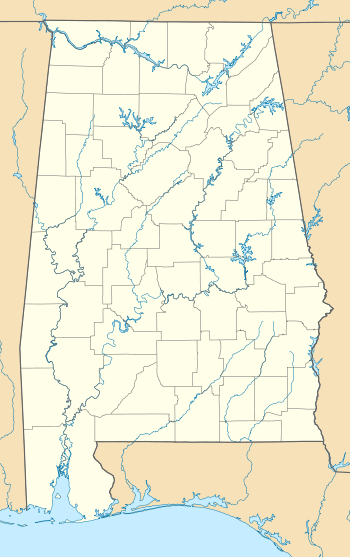Uriah, Alabama
| Uriah, Alabama | |
|---|---|
| Census-designated place | |
 Uriah, Alabama Location within the state of Alabama | |
| Coordinates: 31°18′19″N 87°30′07″W / 31.30528°N 87.50194°WCoordinates: 31°18′19″N 87°30′07″W / 31.30528°N 87.50194°W | |
| Country | United States |
| State | Alabama |
| Counties | Monroe |
| Area[1] | |
| • Total | 1.606 sq mi (4.16 km2) |
| • Land | 1.606 sq mi (4.16 km2) |
| • Water | 0 sq mi (0 km2) |
| Elevation | 351 ft (107 m) |
| Population (2010)[2] | |
| • Total | 294 |
| • Density | 180/sq mi (71/km2) |
| Time zone | CST (UTC-6) |
| ZIP code | 36480 |
| Area code(s) | 251 |
| GNIS ID | 153822[3] |
Uriah is a census-designated place and unincorporated community in Monroe County, Alabama. Uriah is located at the junction of State Route 21 and State Route 59. As of the 2010 census, its population was 294.[2]
Education
The local school, J.U. Blacksher, was named after one of the founding fathers (James Uriah Blacksher) of Uriah. The school houses kindergarten through 12th grade on its campus.
J.U. Blacksher School in Uriah, Alabama, was established in 1924, and graduated its first class in 1925. The building was a large white frame structure built around an open-air garden complete with a goldfish pond.
In January, 1950, the main building burned down. The gym, cafeteria and vocational buildings remained. For two and a half years students attended school at the Masonic Lodge, and CCC Camp at Little River State Park.
In the fall of 1951, the school was rebuilt on its present site with two new brick buildings, the elementary and high school. In 1972, a new cafeteria was completed, and in the fall of 1975, the new gym was completed.
In the spring of 2001, a new eight classroom wing was added on to the backside of the campus and the main office was renovated and enlarged. The football stadium was also renovated receiving new bleachers with a new pressbox. Stadium lights were erected on the baseball field illuminating it for the first time. In 2008, a new elementary wing was added that contained ten new classrooms.
Church Arson Conflict
In 1997, a group of local teenagers were responsible for the arson of a local church and the vandalism of another in the nearby community of Little River. This story and the events leading up to it were documented by author Paul Hemphill in his book The Ballad of Little River.
Culture
Uriah is home to an annual festival called The Cotton Patch Festival. Various talents and arts and crafts are showcased during the festival.
Notable persons
- Carl Madison, former American football coach
- Lambert C. Mims, former mayor of Mobile, Alabama
References
- ↑ "US Gazetteer files: 2010, 2000, and 1990". United States Census Bureau. 2011-02-12. Retrieved 2011-04-23.
- ↑ 2.0 2.1 "American FactFinder". United States Census Bureau. Retrieved 2011-05-14.
- ↑ "Uriah". Geographic Names Information System. United States Geological Survey.
| |||||||||||||||||||||||||||||
